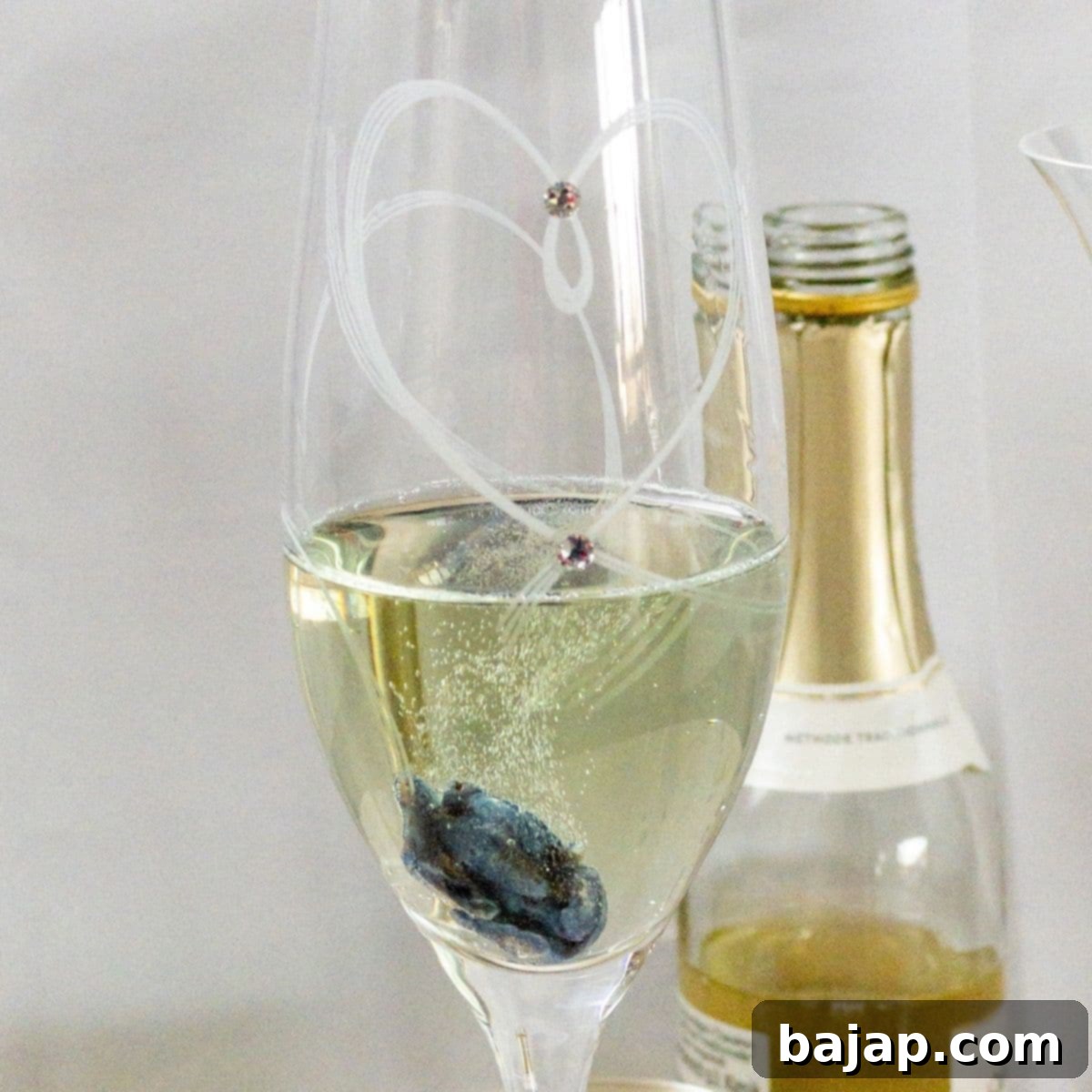Sparkling Wine with Candied Violets: An Elegant Floral Drink for Any Occasion
Discover a truly enchanting and festive beverage that promises to elevate any gathering: sparkling wine infused with delicate candied violets. This stunning drink is more than just a cocktail; it’s an experience, an ideal choice for a lively spring brunch, a sophisticated bridal shower, or simply to make an impression on discerning guests. The visual allure of the vibrant violet sinking gracefully into the bubbling wine is matched only by its delightful taste and aroma.
The subtle sweetness contributed by the candied violets beautifully complements the crisp notes of the sparkling wine, while their wonderful, fresh floral scent instantly transports you to a blooming springtime garden. Each sip is a delicate dance of effervescence and floral elegance, making it an irresistible treat. Imagine enjoying this delicious concoction under the warm sun, feeling its gentle rays on your skin, and letting your soul unwind. This drink isn’t just a recipe; it’s an invitation to savor the moment and embrace the joy of simple pleasures. Try it out and let yourself be utterly enchanted!
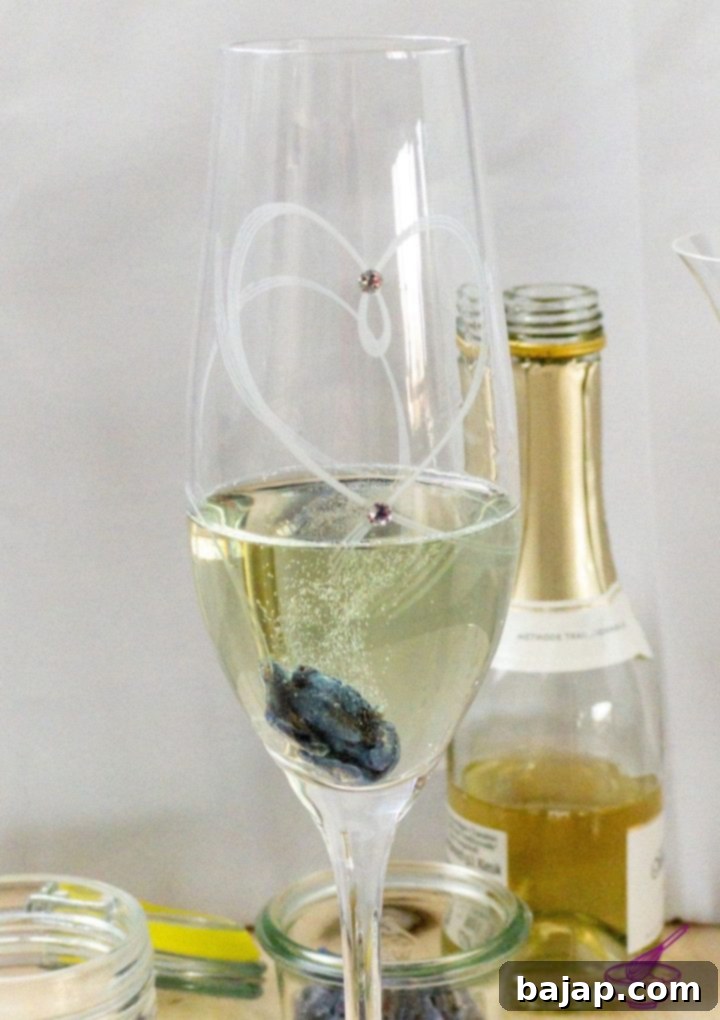
If you’re feeling adventurous and wish to craft these exquisite edible flowers yourself, you’re in luck! Candied violets, famously known as Empress Sissi’s favorite sweet treat, are surprisingly simple to make. For a detailed guide, check out my comprehensive blog post: How to make Candied Violets. Creating them at home adds a personal and deeply satisfying touch to your floral sparkling wine.
This easy-to-prepare drink offers a touch of luxury without requiring extensive effort, making it perfect for both impromptu celebrations and carefully planned events. Its delicate flavor profile and charming presentation are guaranteed to be a conversation starter and a memorable highlight for your guests.
🥘 Ingredients for Candied Violet Sparkling Wine
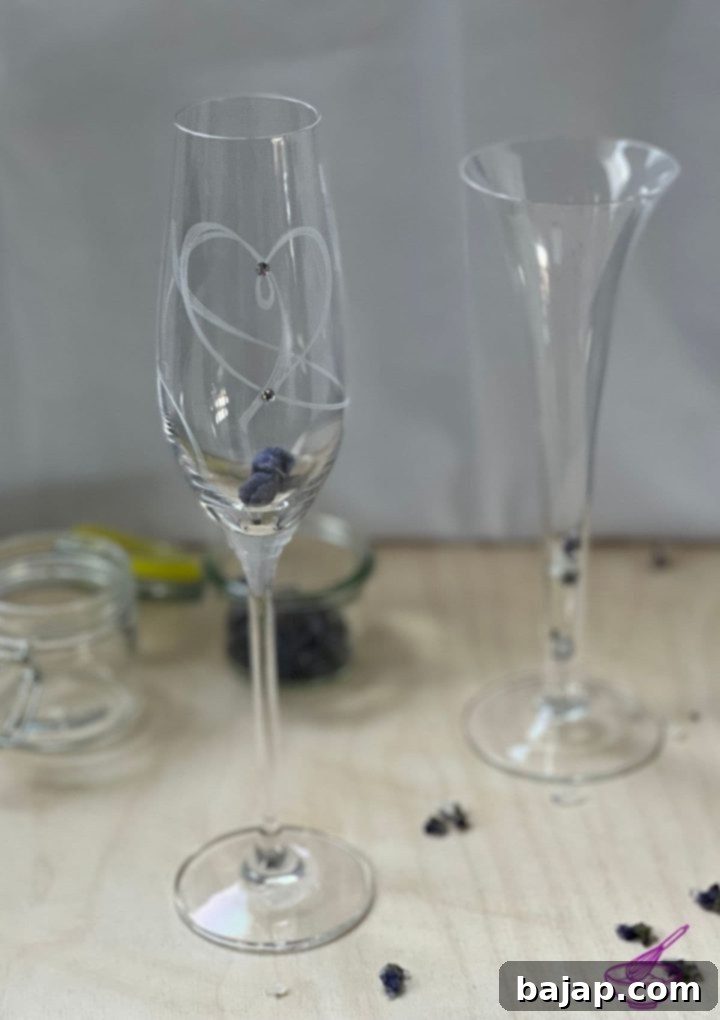
- Sparkling Wine: Choose your favorite! This recipe works beautifully with dry or semi-dry options like Prosecco, Champagne, Cava, or any quality sparkling wine. The key is to select a wine whose flavor won’t overpower the delicate violets.
- Candied Violets: These are the star of the show. You can either use delightful homemade candied violets for an authentic, often less intensely colored and flavored experience, or opt for the convenience and often vibrant hue of store-bought candied violet petals. Both will yield a beautiful drink, with slight variations in color and sweetness.
See the recipe card below for exact quantities based on servings.
🍽 Equipment You’ll Need
Crafting this elegant drink requires minimal equipment, focusing on presentation and enjoyment.
- Champagne flutes or your preferred elegant glasses: Flutes are ideal as they help preserve the bubbles and allow for a beautiful visual display of the violet.
🔪 Step-by-Step Instructions
Preparing this exquisite drink is wonderfully simple, ensuring you spend less time in the kitchen and more time enjoying your guests or relaxing. Follow these easy steps to create your perfect Candied Violet Sparkling Wine:
- Prepare Your Glasses: Depending on the number of guests you’re serving, select one or more elegant champagne glasses. Carefully place a single candied violet in the bottom of each glass. The violet will either rest elegantly at the bottom or float gently, slowly releasing its color and subtle sweetness into the sparkling wine. For this article, I prepared two glasses to illustrate the difference: one with a homemade candied violet and the other with a store-bought one, showcasing their unique characteristics.
- Pour the Sparkling Wine: Once the violets are in place, gently fill each glass approximately ⅔ full with your chosen sparkling wine, prosecco, or champagne. It’s important not to overfill the glass; leaving about a third of the glass empty allows ample space for the sparkling wine’s bouquet to develop. The aroma plays a crucial role in our perception of taste, enhancing the overall drinking experience.
- Observe and Enjoy: The magic begins as soon as the sparkling wine meets the candied violet. The coloring of the sparkling wine occurs very quickly. You’ll notice that store-bought candied violets often release a more vibrant and immediate color, while homemade ones tend to offer a more subtle, delicate tint. This difference also extends to taste; the sparkling wine with purchased candied violets is typically sweeter but might offer a less intense, more sugary violet flavor compared to the nuanced floral notes from homemade ones.
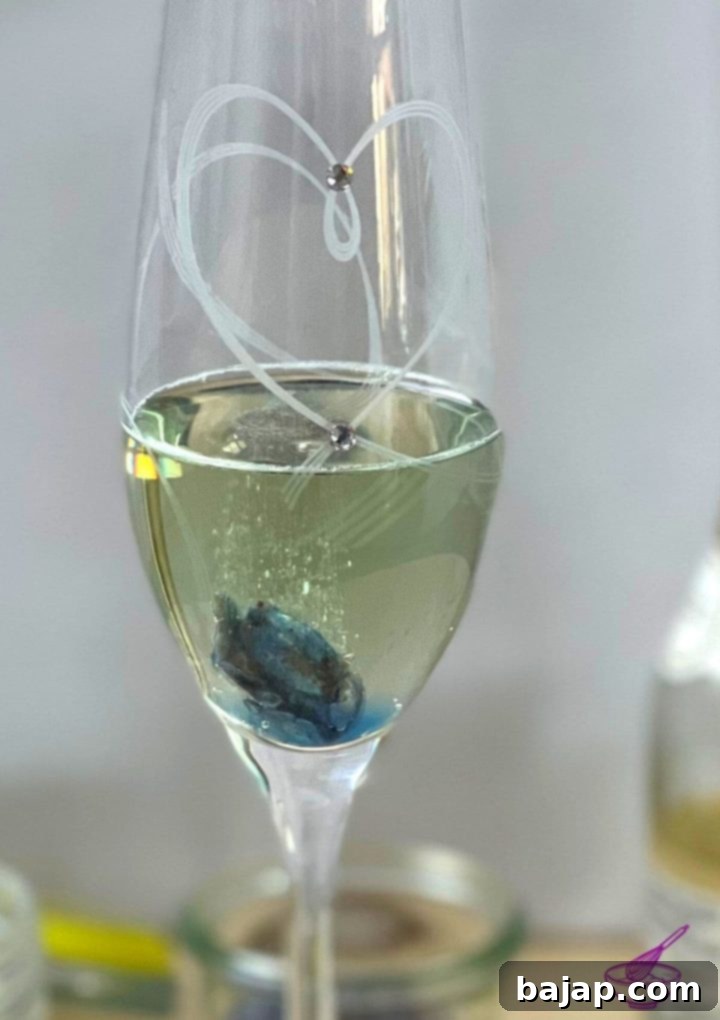
This simple preparation ensures a visually stunning and delicious drink every time. For those who appreciate the homemade touch, remember that making candied violets yourself is a rewarding process. Just follow the easy step-by-step instructions in my dedicated blog post to create your own beautiful edible flowers.
To complement this delightful drink, consider serving a selection of elegant finger foods. Light and airy appetizers, a sophisticated cheese board, or delicate sweet treats are perfect pairings. Delicious desserts such as a rich chocolate bundt cake or delectable chocolate espresso crinkle cookies would beautifully match the subtle sweetness of the drink. For a spring brunch, fruit tarts or mini quiches would also be excellent choices.
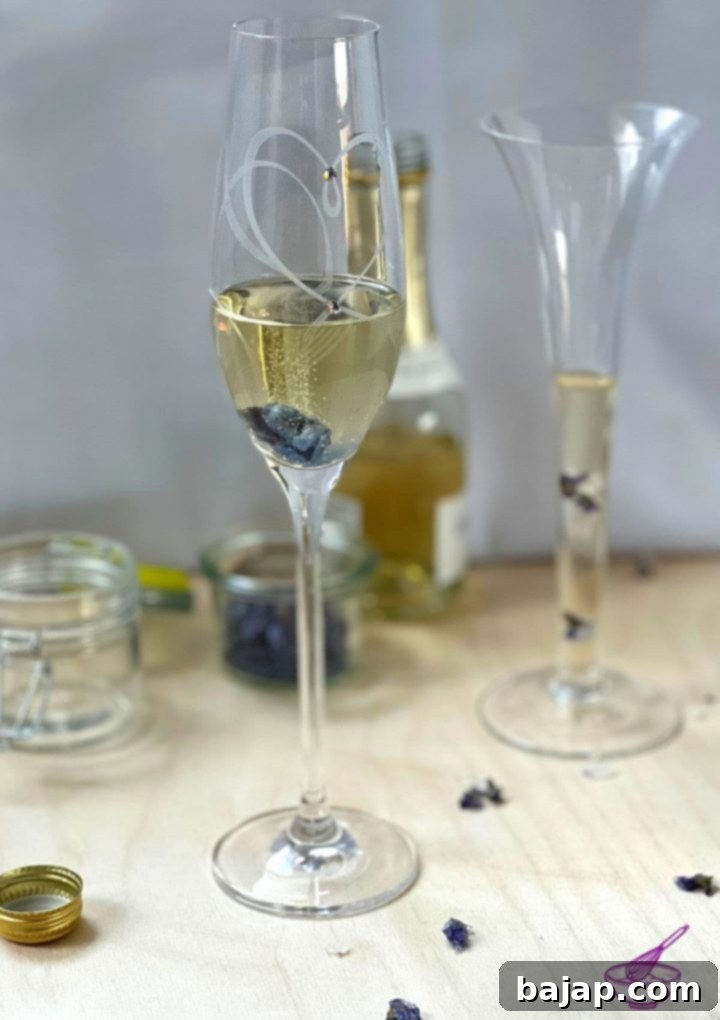
📖 Variations and Personalization
The beauty of this candied violet sparkling wine recipe lies in its simplicity and adaptability. The easiest way to vary this drink is by selecting different types of “bubbly wine.” You can choose from various styles to match your personal preference or the occasion:
- Sparkling Wine: A general term for any wine with significant carbon dioxide. These can range from very dry (Brut) to sweet (Doux). Opt for a Brut or Extra Dry sparkling wine to allow the natural sweetness of the candied violets to shine, or a Demi-Sec if you prefer a sweeter base.
- Champagne: Hailing exclusively from the Champagne region of France, this is the epitome of celebratory sparkling wine. Known for its complex flavors and fine, persistent bubbles, Champagne adds a layer of sophistication. Bruts are most common, but sweeter styles exist.
- Prosecco: An Italian sparkling wine, typically lighter and fruitier than Champagne, with larger, less persistent bubbles. It’s often more affordable and makes an excellent choice for a vibrant, less formal floral drink. Prosecco is usually on the sweeter side, particularly the “Extra Dry” (which despite the name, is slightly sweet) or “Dry” classifications.
- Cava: Spain’s answer to Champagne, Cava is produced using the traditional method, resulting in similar complexity and fine bubbles. It’s often dry and can offer notes of citrus and almond, providing a different backdrop for the violets.
While both Prosecco and Champagne are types of sparkling wines, they differ significantly in production methods, grape varietals used, and their distinct geographical origins. Prosecco typically uses Glera grapes and the Charmat method (second fermentation in tanks), resulting in fresher, fruitier notes. Champagne uses Chardonnay, Pinot Noir, and Pinot Meunier grapes and the traditional method (second fermentation in the bottle), leading to more complex, yeasty, and toasty characteristics. Understanding these differences can help you select the perfect bubbly to complement your candied violets.
Source: pediaa.com
You can also experiment with the number of candied violets for a stronger visual impact or a sweeter taste, though a single violet is usually sufficient to impart its delicate essence and charm.
🌡️ Storage Tips
For the optimal experience, this delightful drink should be served immediately and very cold. Chilling your sparkling wine beforehand is essential to maintain its effervescence and crispness. Once the candied violet is added, it will begin to infuse its flavor and color, so it’s best enjoyed fresh.
If you have leftover candied violets, ensure they are stored correctly to maintain their delicate structure and flavor. Keep them in an airtight container, away from direct sunlight and moisture, in a cool, dry place. This will preserve their freshness and prevent them from becoming sticky or losing their shape, allowing you to enjoy them for future drinks or as a charming edible decoration.
💭 Top Tip for the Best Flavor
When crafting this specific drink, there’s one crucial recommendation to keep in mind for the purest violet flavor: Do not use violet syrup for this recipe. While violet syrups can add a beautiful color and a quick burst of flavor, they often come with a very strong, often artificial, and overly sweet aftertaste that can be too intrusive. This syrup would easily overpower the delicate notes of both the sparkling wine and the natural essence of the candied violets, creating an imbalance.
This particular drink is designed to focus on a subtle, genuine violet note that gently flatters the sparkling wine, rather than dominating the taste profile with too many other aggressive ingredients. The natural infusion from the candied violets offers a much more refined and elegant floral experience.
However, if you do have violet syrup on hand, it’s not entirely without purpose! Consider using violet syrup for other applications, such as crafting different cocktails where a more pronounced floral and sweet element is desired, or even in non-alcoholic sodas and desserts where its intensity can be better managed.
🧐 Interesting Facts About Violets
Violets are not just beautiful; they carry a rich history and a surprisingly versatile profile, especially in the culinary world.
When are violets in season?
The enchanting flowering season for violets mainly spans from March to May, making them a true harbinger of spring. Their vibrant purple blooms are a welcome sight after winter. Occasionally, however, tenacious specimens can be found flowering even into late summer, offering a delightful surprise.
Characteristics of Violets
Beyond their aesthetic appeal and lovely scent, violets possess several notable characteristics:
- Antibacterial: Violets have been traditionally used for their natural antiseptic properties.
- Cough Suppressant: Extracts from violets have been historically used in remedies for coughs and respiratory ailments.
- Analgesic: They are believed to possess mild pain-relieving qualities.
- Soothing: Violets are often associated with calming and comforting effects.
- Cooling: In some traditional practices, they are used for their perceived cooling properties.
How to use Violets in the Kitchen
Violets are incredibly versatile and can be incorporated into various culinary creations:
- Syrup: Violet syrup is relatively easy to prepare and can be used in beverages, desserts, or even as a unique dressing.
- Salad Addition: Fresh violet petals can add a beautiful pop of color and a subtle floral note to green salads.
- Cake Decoration: Candied violets make for exquisite and elegant decorations on cakes, cupcakes, and pastries.
- Drinks: As demonstrated in this recipe, candied violets are perfect for infusing drinks with their unique flavor and visual charm.
Empress Sissi and the Candied Violets
The allure of candied violets is not a modern phenomenon. Empress Elisabeth of Austria, famously known as Empress Sissi (1837-1898), was renowned for her beauty, her strict diet, and her particular fondness for these delicate confections. Despite her rigorous eating habits, she had an undeniable passion for candied violets and purple ice cream. The esteemed imperial court supplier and confectioner Demel, located directly opposite the Hofburg Palace in Vienna, was her regular purveyor of these sweet treats.
A charming legend further intertwines Sissi with this modest flower: “The legend goes that once upon a time in the Prater, when a young lad discovered the first violet in bloom that year, he covered it with his hat. When Empress Sisi passed by on her daily ride, he presented her with the violet. In gratitude, Sisi gave him her riding glove.” This tale perfectly captures the magic and reverence surrounding violets, especially in royal circles.
Frequently Asked Questions (FAQ)
- What type of sparkling wine is best for this recipe?
- A dry or semi-dry sparkling wine, Prosecco, or Champagne works wonderfully. A Brut or Extra Dry option allows the candied violets’ natural sweetness and floral notes to truly shine without being overpowered by a very sweet wine base.
- Can I use fresh violets instead of candied ones?
- While fresh edible violets can be used for garnish, for this particular drink, candied violets are preferred. Candying preserves the flower’s structure and allows it to gradually release its sugar and flavor into the sparkling wine, creating a more cohesive and delightful taste profile. Fresh violets might not infuse the same flavor or maintain their appearance as well.
- How far in advance can I prepare Candied Violet Sparkling Wine?
- This drink is best prepared and served immediately. The bubbles of the sparkling wine are at their peak when freshly poured, and the violet begins its infusion process right away. For the freshest taste and most appealing visual, assemble just before serving.
- Where can I buy candied violets if I don’t want to make them?
- Candied violets can often be found in specialty food stores, gourmet confectionery shops, or online retailers. Brands like India Tree are widely available. Ensure they are specifically marketed as “candied violets” or “crystallized violets” for culinary use.
- Can I make this drink non-alcoholic?
- Absolutely! You can substitute the sparkling wine with sparkling cider, sparkling grape juice, or even a floral-infused sparkling water to create a beautiful non-alcoholic version of this delightful drink.
📖 Recipe
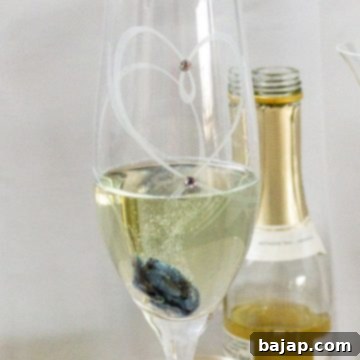
Candied Violets with Sparkling Wine
Nora
Save RecipeSaved!
Pin Recipe
Equipment
-
2 Champagne flutes
Ingredients
- 2 Candied violets
- 1 ⅔ cups Sparkling wine, divided
Instructions
-
Place one of 2 Candied violets in each of the two glasses.2 Candied violets
-
Fill the glass 1 ⅔ cups Sparkling wine, divided, prosecco, or champagne, filling approximately two-thirds full.1 ⅔ cups Sparkling wine, divided
-
Serve immediately and enjoy the floral elegance!
Never miss a recipe!Sign up and let me spoil you weekly with a delicious homemade recipe!
Like this recipe?Mention @combinegoodflavors or tag #combinegoodflavors!
Nutrition values are estimates only, using online calculators. Please verify using your own data.

This Candied Violet Sparkling Wine is more than just a recipe; it’s an invitation to celebrate the smaller joys and add a touch of poetic beauty to your gatherings. Whether for a special brunch, an elegant evening, or just a moment of personal indulgence, this drink promises to delight with its unique blend of visual charm, delicate aroma, and enchanting flavor. Don’t hesitate to try it and share the magic!
🤎 You might also like these delightful recipes
- How to make Candied Violets
- French Press Eggnog Coffee Recipe
- How to make a Snowball Cocktail
- Stracciatella egg liqueur milkshake recipe
⛑️ Food Safety Guidelines
While this recipe is simple, it’s always important to keep food safety in mind, particularly when handling ingredients or serving food to others:
- Cook to a minimum temperature of 165 °F (74 °C) for any ingredients that require heating (not directly applicable here, but a general good practice).
- Do not use the same utensils on cooked food that previously touched raw meat (also not directly applicable, but a general kitchen safety rule).
- Always wash hands thoroughly after touching raw meat or before handling food ingredients.
- Don’t leave food sitting out at room temperature for extended periods, especially drinks that are meant to be served cold.
- Never leave cooking food unattended (a general kitchen safety reminder).
- Use oils with a high smoking point to avoid harmful compounds if any cooking is involved (not directly applicable to this cold drink recipe).
- Always ensure good ventilation when using a gas stove (another general kitchen safety reminder).
For further comprehensive information on safe food handling practices, please refer to the official guidelines from the Safe Food Handling – FDA.
